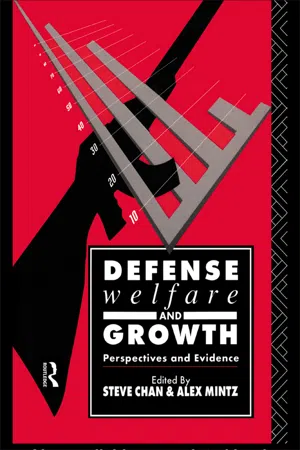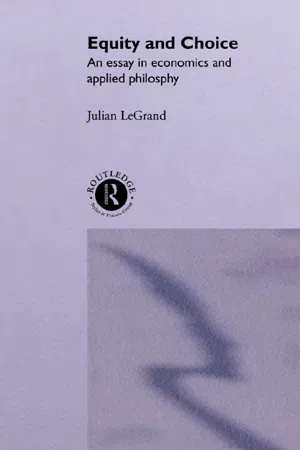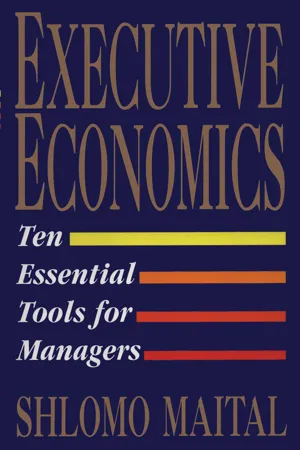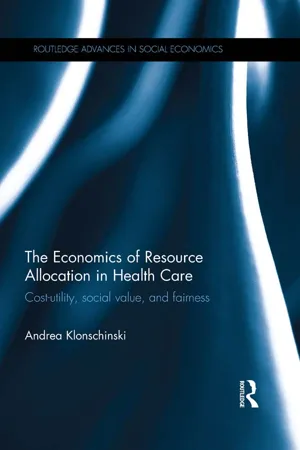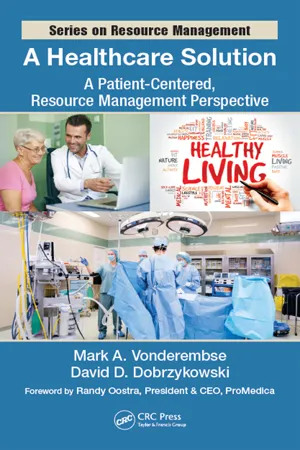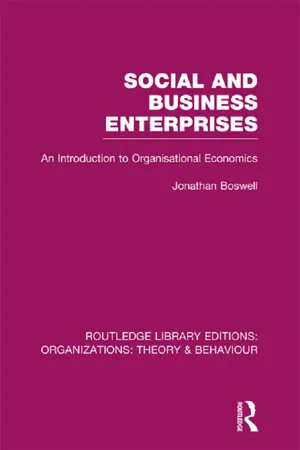Economics
Trade Offs in Economics
Trade-offs in economics refer to the concept of giving up one thing in order to gain something else. It is the idea that in making decisions, individuals, businesses, and governments must weigh the costs and benefits of different options. This principle is fundamental to understanding the allocation of resources and the choices made in economic decision-making.
Written by Perlego with AI-assistance
Related key terms
7 Key excerpts on "Trade Offs in Economics"
- eBook - ePub
Defense, Welfare and Growth
Perspectives and Evidence
- Steve Chan, Alex Mintz(Authors)
- 1992(Publication Date)
- Routledge(Publisher)
impact of the resource-allocation process. As a result, we know very little about the foreign-policy implications of tradeoff decisions, despite the centrality of this relationship in the historical literature (Gaddis 1982; Kennedy 1987; Rasler and Thompson 1989; Tilly 1975).THEORY
Research on the guns-butter issue has been guided less by theory than by the economists’ zero-sum definition of tradeoffs under conditions of resource scarcity (Pechman 1976, 25): ‘From the day he or she opens an elementary economics textbook, the economist learns that economic problems arise from scarcity, and that individuals, businesses, and the nation as a whole must forego some things in order to have other things.’ Note that from this perspective, the existence of tradeoffs is not a hypothesis but a logical requirement: there is by definition always a tradeoff, since resources devoted to defense can in principle be switched to any number of alternative budget categories or reallocated to the private economy through tax reductions. Note also that the tradeoffs implied by this logical identity are subjective: different observers may find it hard to agree on the comparative utility of resources devoted to defense, social security, education, or private savings. As a result, resource allocations are the result of a political bargaining process rather than a process of utility maximization.A political theory of tradeoffs must therefore specify both the desires and the power of societal actors who attempt to influence these inevitable choices. A theory of tradeoffs, like any political theory, must specify who gets what, when and how. With very few exceptions, however, past tradeoff research does not contain such a theory. Although scholars have examined the impact of defense spending on social, educational, health, and a myriad of other programs, there is almost no discussion in the literature of the theoretical reasons for expecting that defense tradeoffs will fall on one budgetary category rather than another. As a result, the myriad of empirical findings are most often reinterpreted in a post hoc - eBook - ePub
Equity and Choice
An Essay in Economics and Applied Philosophy
- Julian Le Grand(Author)
- 1991(Publication Date)
- Routledge(Publisher)
This chapter has made three main points. First, there are two types of trade-off to which the concept of an equity-efficiency trade-off could refer: a value and a production trade-off. In practice, it is often the latter that is of concern; but the two must be kept distinct.Secondly, at least according to one general definition of efficiency—one that refers to society’s ability to attain its primary objectives—the notion of a trade-off between equity and efficiency literally does not make sense; for trade-offs can only occur between these primary objectives, of which efficiency is not one.Thirdly, even if efficiency is interpreted in such a way as to make it a primary objective, such as in terms of economic growth or of Pareto-optimality, there are serious problems in teasing out precisely what is being traded-off against what (in either value or production terms). Pareto-optimality, in particular, is more accurately viewed as a specialized form of social welfare function that itself incorporates a concept of equity; one that, under reasonable assumptions, can be shown to favour the better off. Hence any trade-off between Pareto-optimality and a given conception of equity is not one between efficiency and equity, but is, at least in part, a tradeoff between two different kinds of equity.A final point. It is conventional in economics to treat efficiency, in contrast to equity, as a concept that is relatively unproblematic. If this chapter has done nothing else, it has, I hope, demonstrated that this relative complacency is misplaced. The interpretation of efficiency is as much a complex and value-laden business as the interpretation of equity; a fact that complicates even more the interpretation of the trade-off between them.Appendix 3.1
1 Incentives and social security: an illustration
In Figure 3.3, an individual’s money income, y, is plotted along the vertical axis and her leisure, l - eBook - ePub
Executive Economics
Ten Tools for Business Decision Makers
- Shlomo Maital(Author)
- 2010(Publication Date)
- Free Press(Publisher)
TRADEOFFS Pain versus Gain “There is no gain without pain.” —Adlai StevensonTradeoffs—giving up something in order to get something else—are the mother of all opportunity costs. They lie at the heart of the executive’s job. And they are something of a paradox. The more successful you are, the greater the opportunity costs you face. In fact, success is measured by how well executives create this very thing that haunts and torments them.Every executive faces two tasks. First: to work with courage, skill, perseverance, and creativity to create tradeoffs where none presently exist. If you face no tradeoffs, your company is poorly managed. If you don’t have to settle for less of one thing, to get more of another, then it follows you could have more of everything if you just managed or organized affairs better. That, in turn, means there is much fat and slack in the system, which need to be eliminated. Second: to manage those tradeoffs in the best possible way, balancing gain and pain in a manner that leaves your business best off, with the most gain for the least pain.The textbook cliché for tradeoffs is “guns … or butter.” “Fewer guns could mean a whole lot more butter,” a Business Week article headline stated, in mid-1989. “By eliminating missiles and demobilizing troops, America could reap a sizeable peace dividend by the year 2000.”1 President Ronald Reagan had earlier promised to increase defense spending to match the USSR’s $300 billion defense budget. And he had kept his word. America’s 1981-85 military buildup created over 7 million defense-related jobs. The United States reached parity in defense spending with the USSR in about 1987. Slight reductions in domestic spending and a lot higher arms spending caused a growing deficit.Tradeoffs have a time dimension attached to them. Now that the arms race has ended, defense spending is being cut sharply in America. Shifting workers from defense-related plants to civilian ones—butter factories?—takes a long time. Meanwhile, as some economists have noted, the main peace dividend—not only in America—has so far been unemployment. - Andrea Klonschinski(Author)
- 2016(Publication Date)
- Routledge(Publisher)
These costs reveal the value of the chosen alternative so that economics is essentially “about what people value and how much they value different things” (Williams 2001a: 251). Economists generally take it for granted that human actions comprise these characteristics so that they are describable in terms of trade-offs (see McPherson 1987: 45; Okun 1975: 1; Le Grand 1990: 564; Schefczyk/Priddat 2000; Amadae 2003: 5). 1 This assumption indeed lies at the heart of economics: The discipline is premised on the notion that every decision made by a consumer, producer, bureaucrat or politician involves some kind of trade-off between the different bundles of attributes that make up each choice. Implicit trade-offs can be revealed from decisions made by policy-makers in the public sector, e.g. how the benefits from additional education are weighed against the benefits from using those resources to reduce the risk of death or serious injury. By studying such choices, it is possible to infer the implied value of different goods. (Dolan 2001: 46) 2 When it comes to medical resource allocation, it is accordingly assumed that each prioritization decisions inevitably reveals an equity-efficiency trade-off which allows for inferring the relative value of the equity concern at stake (see Lübbe 2015: 58ff.). This is because any non-health-maximizing decision involves the sacrifice of a certain amount of efficiency in terms of QALYs. These QALYs forgone constitute the opportunity cost of the chosen alternative and, hence, indicate “how much weight a particular equity concern is deemed to merit” (Williams/Cookson 2006: 1). 3 The “central ethical question” then becomes: How much sacrifice to efficiency (e.g., in terms of sum total population QALYs forgone) is it worth making to achieve a particular improvement in equity? This central question can be asked in relation to any reduction in any kind of health inequality, however defined- eBook - ePub
A Healthcare Solution
A Patient-Centered, Resource Management Perspective
- Mark A. Vonderembse, David D. Dobrzykowski(Authors)
- 2016(Publication Date)
- CRC Press(Publisher)
Chapter 8 Viewing Healthcare Trade-Offs PositivelyWhen speaking about healthcare, it may seem like an oxymoron to put the words trade-off and positively together. A trade-off is giving up one thing to gain another. For example, people buy full-size pickup trucks to haul stuff and pull trailers for work, but the gas mileage is much lower than small economy cars. Plus, pickup trucks can cost twice as much. Similarly, investors who wish to save money buy and sell stocks online, but these investors do not get the advice and council of a full-service stock broker. However, when it comes to their health, few people believe they should compromise—that is, make trade-offs and be satisfied with something less than the “best” care. In addition, a trade-off is a mechanism for allocating scare resources, and many people believe and act as though healthcare is a limitless resource.The notion that healthcare is an unlimited resource collides with the reality that resources in the United States, or any nation, are finite. Even if there is a way to spend the United States’ entire gross domestic product (GDP) on healthcare, the available resources are still finite. With all resources devoted to healthcare, every job would be in healthcare directly, such as nurses and physicians, or indirectly, such as biotech researchers and surgical equipment designers. All facilities and equipment would be converted to healthcare use. This leaves no one and no equipment to purify water, grow food, make clothing, construct houses, build transportation infrastructure, or provide other essential goods and services. No country can do this, so healthcare spending must be substantially less than the GDP. This begs the following questions:1. How much can the United States afford to spend on healthcare—that is, what percentage of the GDP is the right amount? 2. How should these finite healthcare resources be allocated?From a free market perspective, the first question is the wrong question. The United States does not set GDP targets for how much to spend on mobile phones, food, or tax accounting services. Demand and supply for these items are set by markets in which people make decisions or trade-offs that determine how they allocate their limited resources. Decisions to purchase items depend on their costs and benefits. This book examines and attempts to change the phenomena that underlie healthcare decision making. Key objectives of this book are to clarify why tradeoffs are necessary and help people make good choices by considering both sides of the demand–supply balancing act. The solution accomplishes this by doing the following: - eBook - ePub
Social and Business Enterprises (RLE: Organizations)
An Introduction to Organisational Economics
- Jonathan Boswell(Author)
- 2013(Publication Date)
- Routledge(Publisher)
Chapter 5 Opportunity Cost In some ways the idea of opportunity cost is complementary to that of marginalism. Whereas marginalist reasoning in its useful modified form concentrates on keen adjustments and flexible improvements, opportunity cost reasoning is part of the very act of choice. Practical marginalism is essentially tactical but opportunity cost tends to be more strategically oriented, more critical and, in a sense, more radical. Of the two ideas it is also the more important. If marginalism in the pure sense is unattainable – and in the modified sense a matter of optional effort – opportunity cost is inescapable and perpetually pressing in on us, whether we like it or not. It is inherent in the whole human condition, fraught with triumph and tragedy. The critical question is whether we recognise it properly and apply its rationale with lucidity. DEFINITION AND TYPES OF OPPORTUNITY COST Opportunity cost is the value of the opportunity sacrificed, or the benefit forgone, as a result of not employing something in its best alternative use as seen by decision makers and/or society. James Buchanan expresses the contrast between historical and opportunity costs succinctly as a contrast between ‘choice influenced’ and ‘choice influencing’ costs. 1 In thinking about opportunity cost the key terms are ‘alternatives’, ‘relinquishment’, ‘sacrifice’ and ‘displacement’. Relating these to individual experience, we may say that the opportunity cost of saving money is the benefit from the spending abstained from or postponed as a result. The opportunity cost of depositing money in a building society is measured by the return anticipated from investing in, say, government stock or perhaps equities - eBook - ePub
Structured Decision Making
A Practical Guide to Environmental Management Choices
- Robin Gregory, Lee Failing, Michael Harstone, Graham Long, Tim McDaniels, Dan Ohlson(Authors)
- 2012(Publication Date)
- Wiley-Blackwell(Publisher)
This chapter introduces what we mean by trade-offs and why they matter. It summarizes research on how people think about them and then outlines an approach for dealing constructively with trade-offs in a deliberative environment. We end, as in other chapters, with some tips for dealing with tricky but common situations involving tough trade-offs faced by groups working on environmental management decisions.The approaches we’ve chosen to highlight are not the only ways to make multi-attribute choices. You’ll find many other methods in the literature and we provide some references at the end of the chapter. Our focus is on methods that we believe are at once: (a) technically sound – at least enough to be sure they won’t be the weak link in your analysis; b) useful in facilitating dialogue and producing insights in a deliberative environment, and; (c) understandable and intuitively appealing to a broad range of both technical and non-technical people. Of course, these attributes are not entirely independent. The methods we present here are also largely methods that can be implemented effectively by environmental managers without a great deal of specialized training or proprietary software.9.1 The basics 9.1.1 What are trade-offs and why do we need to make them?Value trade-offs involve making judgments about how much you would give up on one objective in order to achieve gains on another objective. They are inevitable in a process that develops a creative range of alternatives. Of course, a creative decision process may also deliver win–wins – gains relative to the status quo for many or all objectives. But if you’ve done your job up to this stage, the alternatives still on the table will each deliver a different balance across the objectives and, as a result, making a choice among them involves making value-based trade-offs.Some people don’t like the term trade-offs – it has connotations of giving up something of value, perhaps in an unfair trade. If this is a concern then you can think of it as finding an acceptable balance across objectives, or simply making tough choices. The key point is that sensible decisions need to be based on the specific amounts of anticipated gains and losses, rather than on some general statement of principles or priorities. This point is important. We almost never ask for general priorities in SDM applications, whereas it’s common elsewhere – public opinion surveys, for example, often include questions such as: what’s more important, the economy or the environment? For nearly all resource-management decisions, such questions are meaningless – beyond understanding the broadest notion of a person’s worldviews – and any specific application of their answers may be misleading (see Text box 9.1
Index pages curate the most relevant extracts from our library of academic textbooks. They’ve been created using an in-house natural language model (NLM), each adding context and meaning to key research topics.
